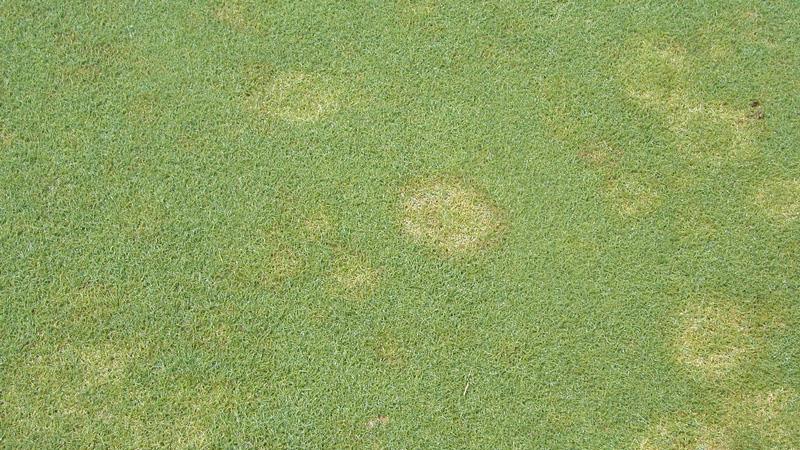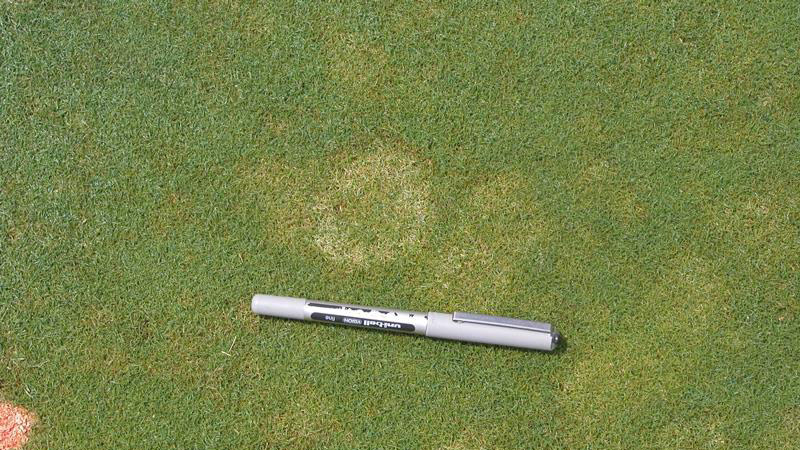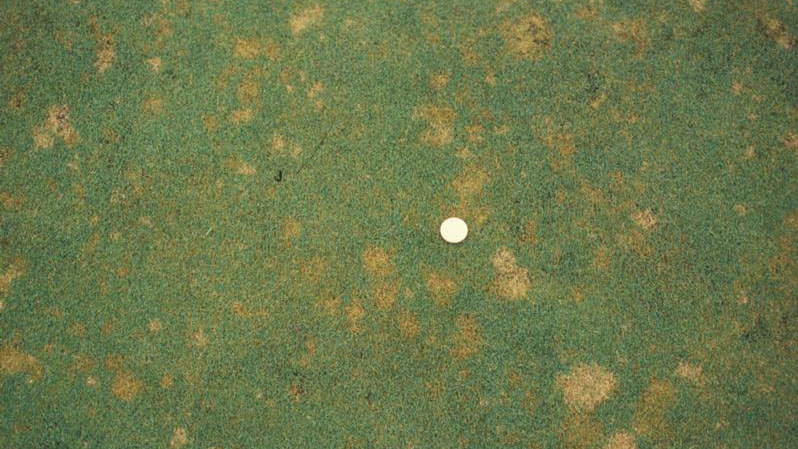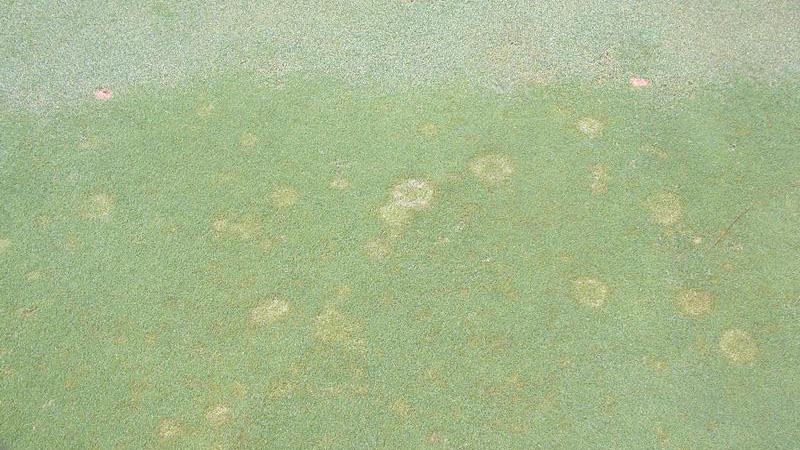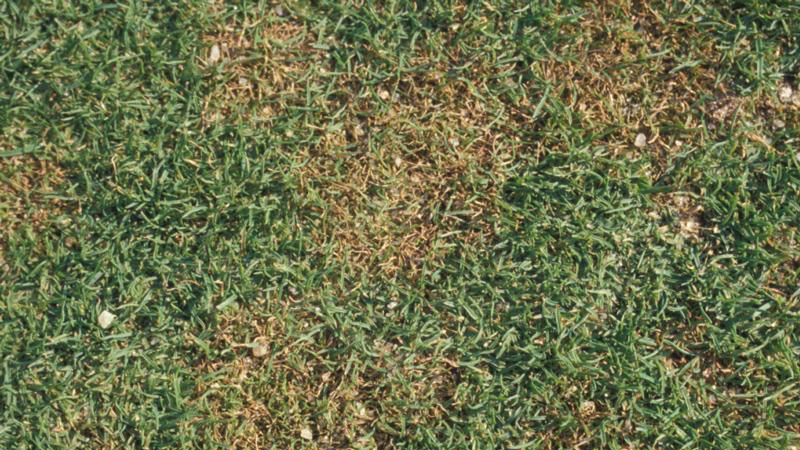Copper Spot in Turf
en Español / em Português
El inglés es el idioma de control de esta página. En la medida en que haya algún conflicto entre la traducción al inglés y la traducción, el inglés prevalece.
Al hacer clic en el enlace de traducción se activa un servicio de traducción gratuito para convertir la página al español. Al igual que con cualquier traducción por Internet, la conversión no es sensible al contexto y puede que no traduzca el texto en su significado original. NC State Extension no garantiza la exactitud del texto traducido. Por favor, tenga en cuenta que algunas aplicaciones y/o servicios pueden no funcionar como se espera cuando se traducen.
Português
Inglês é o idioma de controle desta página. Na medida que haja algum conflito entre o texto original em Inglês e a tradução, o Inglês prevalece.
Ao clicar no link de tradução, um serviço gratuito de tradução será ativado para converter a página para o Português. Como em qualquer tradução pela internet, a conversão não é sensivel ao contexto e pode não ocorrer a tradução para o significado orginal. O serviço de Extensão da Carolina do Norte (NC State Extension) não garante a exatidão do texto traduzido. Por favor, observe que algumas funções ou serviços podem não funcionar como esperado após a tradução.
English
English is the controlling language of this page. To the extent there is any conflict between the English text and the translation, English controls.
Clicking on the translation link activates a free translation service to convert the page to Spanish. As with any Internet translation, the conversion is not context-sensitive and may not translate the text to its original meaning. NC State Extension does not guarantee the accuracy of the translated text. Please note that some applications and/or services may not function as expected when translated.
Collapse ▲Symptoms
Copper spot is a disease of bentgrass species that develops during periods of warm and humid weather. Velvet bentgrass is particularly susceptible to the disease, but it is occasionally observed on creeping bentgrass as well. As the name implies, copper spot appears in small spots, usually less than 3 inches in diameter, that are copper or salmon in color. The disease causes a foliar blight, so distinct lesions or leaf spots are not evident on individual plants. When the turf is wet or humidity is high, the infected leaves may be covered with a thin, gelatinous coating of fungal spores.
Development Factors
Copper spot develops during periods of warm, wet weather. The pathogen is most active when temperatures are between 65 and 85°F. High humidity, frequent rainfall, or over-irrigation favors rapid infection and heavy sporulation. Unlike dollar spot, the development of copper spot is enhanced by excessive nitrogen levels. The disease is also more severe when soil pH is 5.5 or lower.
Cultural Control
Avoid excessive nitrogen by using granular fertilizers with a blend of quick and slow release forms. In general, no more than 0.25 lb of water-soluble nitrogen should be applied to creeping bentgrass at any one time. Removal of dew in the morning by mowing, whipping, or dragging will shorten leaf wetness periods and discourage copper spot development. Practice deep and infrequent irrigation to minimize periods of leaf wetness. Prune or remove trees surrounding golf course putting greens to increase air movement and sunlight penetration. Installation of high-powered fans will also help to minimize copper spot development in areas where air movement is restricted. Creeping bentgrass performs best when soil pH is between 5.5 and 6.5, but pH should be maintained above 6.0 where annual bluegrass is being cultured. Annual soil testing should be used to determine if lime applications are needed to maintain soil pH in this optimal range.
Chemical Control
Little is known about the performance of fungicides for copper spot control. Where the disease has been a persistent problem, apply a labeled fungicide every 14 to 21 days when conditions are conducive to copper spot outbreaks. In other areas, the disease can be controlled curatively if it is detected early. Tank-mixtures of contact and systemic fungicides are most effective after copper spot symptoms appear.
* Products marked with an asterisk are not labeled for home lawn use.
| Fungicide and Formulation1 | Amount of Formulation2 | Application Interval (Days)3 | Efficacy Rating | Resistance Risk | FRAC Code4 |
|
benzovindiflupyr + difenoconazole (Ascernity)* |
1.0 | 14 | ? | ? | 7/3 |
|
boscalid + chlorothalonil (Encartis)* |
4 | 14 | ? | ? | 7/M5 |
|
chlorothalonil (Daconil Ultrex)* |
3.7 to 5 |
14 |
+ | ? | M5 |
| chlorothalonil (Daconil Weather Stik)* | 4 to 5.5 | 14 | + | ? | M5 |
| chlorothalonil (Daconil Zn)* | 6 to 8 | 14 | + | ? | M5 |
| chlorothalonil + acibenzolar-S-methyl (Daconil Action)* | 4 to 5.4 | 14 | ? | ? | M5/P01 |
| chlorothalonil + azoxystrobin (Renown)* | 2.5 | 14 | ? | ? | M5/11 |
| chlorothalonil + fluoxastrobin (Fame C)* | 5.9 | 14 | + | ? | M5/11 |
| chlorothalonil + iprodione + thiophanate-methyl + tebuconazole (Enclave)* |
3 to 4 7 to 8 |
14 to 21 28 |
? |
? | M5/2/1/3 |
| chlorothalonil + propiconazole (Concert)* | 5.5 to 8.5 | 14 | ++ | ? | M5/3 |
| chlorothalonil + thiophanate-methyl (Spectro)* | 3 to 5.76 | 14 | +++ | ? | M5/1 |
|
fluindapyr + flutriafol (Kalida) |
0.25 to 0.4 | 7 to 14 | ? | ? | 7/3 |
| flutriafol (Rayora)* | 0.7 to 1.4 | 14 to 21 | ? | ? | 3 |
| iprodione + thiophanate-methyl (26/36)* | 2 to 4 | 14 to 21 | +++ | ? | 2/1 |
| mancozeb (Fore)* (Dithane)* |
4 to 8 4 to 8 |
7 to 14 10 |
+ | ? | M3 |
| myclobutanil (Eagle) | 1.2 | 14 | ? | ? | 3 |
| tebuconazole (Torque)* |
0.6 to 1.1 | refer to label | ? | ? | 3 |
| thiophanate-methyl (3336) (3336 Plus) |
2 to 4 2 to 4 |
14 14 to 28 |
? | ? | 1 |
| triadimefon (Bayleton) | 0.5 to 1 | 15 to 30 | +++ | ? | 3 |
| 1 Other trade names with the same active ingredients are labeled for use on turfgrasses and can be used according to label directions. 2 Units are oz, fl oz, or lb depending on formulation. Apply fungicides in 2 to 5 gallons of water per 1,000 square feet according to label directions. Use lower rates for preventive and higher rates for curative applications. 3 Use shorter intervals when conditions are very favorable for disease. 4 Fungicide Resistance Action Committe code. Products with same code have the same mode of action and are in the same chemical class. * Products marked with an asterisk are not labeled for home lawn use. |
|||||
| Efficacy Rating ++++ = excellent control when conditions are highly favorable for disease development +++ = good control when disease pressure is high, excellent control when disease pressure is moderate ++ = good control when disease pressure is moderate, excellent control when disease pressure is low + = good control when disease pressure is low ? = not rated due to insufficient data |
|||||
| Resistance Risk Low = Rotate to different chemical class after 3-4 applications; tank mixing not necessary Medium = Rotate to different chemical class after 1-2 applications; tank-mixing with low or medium risk product recommended High = Rotate to different chemical class after EVERY application; tank-mix with low or medium risk product for EVERY application ? = not rated due to insufficient data |
|||||
Species Data
- HOST SPECIES
- creeping bentgrass, annual bluegrass
- MONTHS WITH SYMPTOMS
- April to September
- STAND SYMPTOMS
- spots
- FOLIAR SYMPTOMS LOCATION / SHAPE
- blighting of entire leaves
- FOLIAR SYMPTOMS COLOR
- tan, orange, red, pink
- ROOT / CROWN SYMPTOMS
- none
- FUNGAL SIGNS
- mycelium, jelly-like spore-masses




